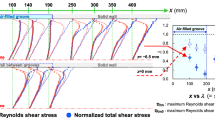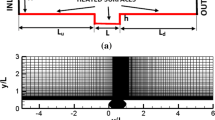Abstract
The drag reduction effect of super-hydrophobic surface induced by the entrapped gas is unstable due to the gradual disappearance of the trapped gas. In this paper, a hydrophobic transverse grooved surface was designed to sustain gas in valleys. A detail numerical simulation was presented to investigate the flow field near the proposed surface. When water flowed over this surface, the entrapped gas was blocked by the ridges and the solid-liquid interface was replaced by the liquid-gas interface due to the entrapped gas, furthermore the micro-vortex formed in the groove. Because there was an effective slippage between water and solid induced by the entrapped gas, the velocity gradient of boundary layer decreased, which contributed to a remarkable drag reduction effect. Additionally, considering the extra undesired pressure drag reduction which negatively impacted the drag reduction effect of this method, the total drag coefficient including the viscous drag coefficient and the pressure coefficient was analyzed. An effective drag reduction rate of about 15% was achieved and the effect of this method was confirmed by experiments conducted in a high-speed water tunnel when grooves were optimized.
Similar content being viewed by others
References
Jiang C G, Xin S C, Wu C W. Drag reduction of a miniature boat with superhydrophobic grille bottom. AIP Adv, 2011, 1(3): 032148
Zhang D Y, Li Y Y, Han X, et al. High-precision bio-replication of synthetic drag reduction shark skin. Chin Sci Bull, 2011, 56(9): 938–944
Walsh M J. Riblets as a viscous drag reduction technique. AIAA J, 1983, 21(4): 485–486
Choi J, Jeon W P, Choi H. Mechanism of drag reduction by dimples on a sphere. Phys Fluids, 2006, 18: 041702
García-Mayoral R, Jiménez J. Drag reduction by riblets. Phil Trans R Soc A, 2011, 369(1940): 1412–1427
Ranjan P, Ranjan A R, Singh A P. Computational analysis of frictional drag over transverse grooved flat plates. Int J Eng Sci Tech, 2011, 3(2):110–116
Martell M B, Rothstein J P, Perot J B. An analysis of superhydrophobic turbulent drag reduction mechanisms using direct numerical simulation. Phys Fluids, 2010, 22(06): 065102
Martell M B, Perot J B, Rothstein J P. Direct numerical simulations of turbulent flows over superhydrophobic surfaces. J Fluid Mech, 2009, 620(1): 31–41
Shirtcliffe N J, McHale G, Newton M I, et al. Superhydrophobic copper tubes with possible flow enhancement and drag reduction. ACS Appl Mater Inter, 2009, 1(6): 1316–1323
Mowla D, Naderi A. Experimental study of drag reduction by a polymeric additive in slug two-phase flow of crude oil and air in horizontal pipes. Chem Eng Sci, 2006, 61(5): 1549–1554
Yang S Q, Dou G. Turbulent drag reduction with polymer additive in rough pipes. J Fluid Mech, 2010, 642(1): 279–294
Li F C, Kawaguchi Y, Yu B, et al. Experimental study of drag-reduction mechanism for a dilute surfactant solution flow. Int J Heat Mass Tran, 2008, 51(3): 835–843
Ceccio S L. Friction drag reduction of external flows with bubble and gas injection. Annu Rev Fluid Mech, 2010, 42: 183–203
Gutierrez-Torres C C, Hassan Y A, Jimenez-Bernal J A. Turbulence structure modification and drag reduction by microbubble injections in a boundary layer channel flow. J Fluids Eng, 2008, 130(11): 111304
Vakarelski I U, Marston J O, Chan D Y C, et al. Drag reduction by Leidenfrost vapor layers. Phys Rev Lett, 2011, 106(21): 214501
Kumari N, Garimella S V. Electrowetting-induced dewetting transitions on superhydrophobic surfaces. Langmuir, 2011, 27(17): 10342–10346
Lee C, Kim C J. Underwater restoration and retention of gases on superhydrophobic surfaces for drag reduction. Phys Rev Lett, 2011, 106(1): 014502
Hara K, Suzuki T, Yamamoto F. Image analysis applied to study on frictional-drag reduction by electrolytic microbubbles in a turbulent channel flow. Exp Fluids, 2011, 50(3): 715–727
Gao X, Jiang L. Biophysics: Water-repellent legs of water striders. Nature, 2004, 432(7013): 36–36
Fukagata K, Kasagi N, Koumoutsakos P. A theoretical prediction of friction drag reduction in turbulent flow by superhydrophobic surfaces. Phys Fluids, 2006, 18(5): 051703
Belyaev A V, Vinogradova O I. Effective slip in pressure-driven flow past super-hydrophobic stripes. J Fluid Mech, 2010, 652: 489–499
Tsai P, Peters A M, Pirat C, et al. Quantifying effective slip length over micropatterned hydrophobic surfaces. Phys Fluids, 2009, 21(11): 112002
Choi C H, Ulmanella U, Kim J, et al. Effective slip and friction reduction in nanograted superhydrophobic microchannels. Phys Fluids, 2006, 18(8): 087105
Choi C H, Kim C J. Large slip of aqueous liquid flow over a nanoengineered superhydrophobic surface. Phys Rev Lett, 2006, 96(6): 066001
Lee C, Choi C H, Kim C J. Structured surfaces for a giant liquid slip. Phys Rev Lett, 2008, 101(6): 064501
Lee C, Kim C J. Maximizing the giant liquid slip on superhydrophobic microstructures by nanostructuring their sidewalls. Langmuir, 2009, 25(21): 12812–12818
Teo C J, Khoo B C. Flow past superhydrophobic surfaces containing longitudinal grooves: Effects of interface curvature. Microfluid Nanofluid, 2010, 9(2–3): 499–511
Byun D, Kim J, Ko H S, et al. Direct measurement of slip flows in superhydrophobic microchannels with transverse grooves. Phys Fluids, 2008, 20(11): 113601
Govardhan R N, Srinivas G S, Asthana A, et al. Time dependence of effective slip on textured hydrophobic surfaces. Phys Fluids, 2009, 21(5): 052001
Cassie A B D, Baxter S. Wettability of porous surfaces. Trans Faraday Soc, 1944, 40: 546–551
Wenzel R N. Resistance of solid surfaces to wetting by water. Ind Eng Chem, 1936, 28(8): 988–994
Wang J D, Chen D R. Criteria for entrapped gas under a drop on an ultrahydrophobic surface. Langmuir, 2008, 24(18): 10174–10180
Ding B, Ogawa T, Kim J, et al. Fabrication of a super-hydrophobic nanofibrous zinc oxide film surface by electrospinning. Thin Solid Films, 2008, 516(9): 2495–2501
Dou Z L, Wang J D, Yu F, et al. Fabrication of a micro-structured surface based on interfacial convection for drag reduction. Chin Sci Bull, 2011, 56(7): 626–632
Author information
Authors and Affiliations
Corresponding author
Rights and permissions
About this article
Cite this article
Wang, B., Wang, J. & Chen, D. A prediction of drag reduction by entrapped gases in hydrophobic transverse grooves. Sci. China Technol. Sci. 56, 2973–2978 (2013). https://doi.org/10.1007/s11431-013-5395-y
Received:
Accepted:
Published:
Issue Date:
DOI: https://doi.org/10.1007/s11431-013-5395-y




